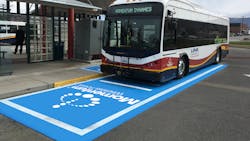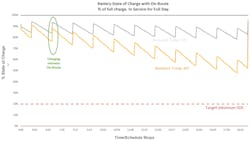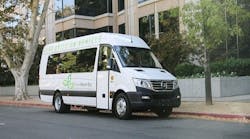Electric Mass Transit: Are we interpreting the first experiences with electric buses meaningfully?
Many of us remember lab experiments from college; they were conducted under controlled conditions with a well-defined purpose and yielded predictable results. Within an academic setting, they served to reinforce a well-understood concept that had been taught in lecture.
Alas, if only testing electric buses under real-life conditions were so simple.
Those of us who live in the EV fleet world are aware that many North American mass transit fleets have taken on pilot projects (let’s call these experiments) with a small number of battery electric buses in the past few years. Those pilot projects are now starting to yield informative results. The information we are gaining, however, requires a probing and objective interpretation rather than a perfunctory reinforcement of a well-understood principle. As with all laboratory experiments, we should understand that this early testing has not been representative of real-world conditions; in fact, results may be misleading due to their scale and due to their failure to consider the latest technological innovations.
In the larger sense, the most important first observations from these pilot projects are very encouraging: Battery-electric buses do indeed work and they clearly have a positive societal impact. One needs to look no further than recent NASA satellite imagery of major city air pollution before and after the current pandemic to discover that an accelerated changeover to electrified transportation is a moral imperative. The exciting double bottom line in this proposition is that electric buses, if implemented properly, are not only cleaner, they can save their operators a great deal of money. But – and this is the important part – only if the fleet transition is implemented from the outset with careful study and planning for charging infrastructure. In fact, what we have learned most clearly is that it is the design of the charging infrastructure that will truly determine the ultimate success of a bus electrification program.
Why do I say this? I say it because what was originally suspected is now undeniable: Electric buses have a driving range problem. If they rely exclusively on once-per-day overnight “plug-and-play” recharging at the garage, they frequently cannot drive far enough on a single charge to meet a full day’s driving requirements. This fact makes it very difficult for a battery electric bus to replace a fossil fuel bus one-for-one. And therein lies a fundamental problem. The need to buy more buses means higher vehicle costs, a capital expense that can negate the potential cost advantage of electric buses.
But this thinking assumes that the operating model is constrained to the once-per-day overnight charge routine. This is the faulty assumption in the bus pilot experiment in those instances where the alternative charging method of on-route opportunity charging has been overlooked. With on-route charging, the driving range of the bus is extended by adding supplemental energy during the daily driving routine – without adding weight or cost to the bus or any alternation of route schedules. This infrastructure-side advantage fundamentally changes the outcome of the experiment in terms of operational effectiveness and economics.
When on-route charging is not utilized in pilot projects, there are real concerns that operators are misinterpreting pilot test results in two contrasting ways:
- Some fleet operators, having discovered that their bus suppliers’ claimed and rated range predictions were optimistic (especially in cold weather) have prematurely concluded that EV buses simply cannot meet range expectations.
- Conversely, other fleet operators, lulled into a false sense of security by managing perhaps fewer than a half dozen buses that are manually charged at the depot, may have adopted the belief that their depot can easily scale up to hundreds of buses. They may have made this assumption thinking that all of these buses could charge simultaneously without considering the space and labor requirements of a plug-in charger solution, the increase in power demand that would be required or the need for expensive power infrastructure upgrades.
Let’s examine the first situation. No doubt some operators have been disappointed with the range of their vehicles in real-world situations. This was a predictable result with countless analogs in the history of the introduction of new technologies. Early underperformance is eventually improved by rapid technological advancement. Expectations of capability shift with mind-boggling speed in periods of rapid innovation. And that is what we are now experiencing in the world of electric vehicles. But the solution is not to add more battery to the vehicle, it is to shift the burden from the vehicle to the infrastructure. In other words, shift to a more efficient and frequent way of electric fueling that effectively extends the driving range of the bus.
Our partnership with Link Transit in Wenatchee, Wash., has yielded impressive results that prove this point. Link is representative of other projects, and in this four-season experiment, the on-route charging infrastructure automatically delivered 45 MWh of energy to a bus in a two-year period beginning in February 2018. This is a breakthrough in bus electrification because it proves that an electric bus can outperform a fossil fuel bus in every measurable dimension – including the costs associated with charging equipment costs, maintenance and electric refueling.
Even better, with on-route automated charging, fleet operators will find that they need fewer buses, and potentially lighter and less-expensive buses than they might have otherwise thought practicable. By shifting the load to the infrastructure side, it becomes possible to remove battery packs from the vehicle, making the bus lighter and less expensive.
Now let’s look at the second situation where the operator does not realize they have a problem because the number of buses in the test sample is small and the bus operator believes that the results of the pilot program can simply be scaled up on the same cost basis as the original pilot.
Charging fewer than 10 buses overnight is very different than charging 100 or even 200 buses simultaneously from a single supply source in one central location. The charging electrical demand is multiplied, of course, but the operational difficulty grows disproportionately. A dedicated worker that is required to plug and unplug 200 buses at five minutes per bus will require more than 16 man hours per shift to move from bus to bus while connecting and disconnecting literally hundreds of cables traversing the depot. And then there is the unavoidable problem that there is no room for the requisite number of distributed charging cabinets. That is simply a crazy waste of labor, space and resources.
Contrast this with a distributed system that is operated automatically. Fewer chargers are required because each on-route ground station can be shared by multiple buses. We can completely remove the need for a central electrical substation, eliminate the cables and cabinets within the depot, and avoid the costs of additional staff to operate a manual system.
With inductive charging we have the capability to send a bus on its route, for it to seamlessly charge in incremental partial charges along its route, and then to return to depot with a battery that is at least 80 percent full – every day, day after day. For example, in early 2020, a wirelessly charged bus ran a 14-hour scheduled route in 30-degree weather and maintained its battery state-of-charge above 90 percent throughout the journey, without the need for driver intervention and without ever being plugged in.
The truly beautiful part is that you never even see the charger, so the city planner is satisfied, the bus rider is happily unaware and the fleet operator meets mandates to reduce emissions while saving money. In larger agencies this can be many millions of dollars in savings per year after a rapid pay-off period for the cost of the charging infrastructure.
The grid supplier likes this too because with on-route-charged buses returning to depot at better than 80 percent full batteries, the overall demand at the depot won’t mandate extremely costly upgrades to the supporting electric grid (and the time they take to engineer and install), nor will there be a new and massive demand spike. This problem is just now coming into view. It has not been a problem for bus operators running a pilot-sized fleet of buses but it is emerging as a financial burden to many metropolitan transit agencies around the world that are working with larger fleets. And it is a problem without a clear solution or benefactor.
We can do better. We can solve this problem from the outset with inductive charging. No plugs, no cables, no wearable parts, no missed connections, no redesign of facilities. And all of it compatible with and encouraging of many decades of future innovation.
As we stand today with early results in hand from a small and scattered test sample, are we ready to interpret the findings properly? Are we prepared to recognize the early trends as exactly that – early trends – and then properly extrapolate to full scale deployments? Doing so requires us to ask the right questions to ensure that we will build a fully capable, affordable and future-proofed approach to electric bus transit operations.
The future of emission-free mass transit is waiting on our answers.
------------------------------------------------------

Andrew Daga | Founder, president and CEO of Momentum Dynamics
Andrew Daga is the founder, president and CEO of Momentum Dynamics.
Andy’s fascinating story takes him from his birthplace of Brooklyn, N.Y., through Ithaca, N.Y., where his family developed the best Italian restaurant in town through Hawaii, degrees in structural and civil engineering, architecture and space science and technology, ground-breaking work at NASA and his current role at Momentum Dynamics.
Prior to founding Momentum Dynamics, Andy was a leading consultant to the aerospace industry and contributed to the design of the International Space Station solar power array system, the Mars Pathfinder program, and future mission planning studies with NASA and the U.S. Department of Defense.
Andy will admit that this layered journey wasn’t fully planned, but nor did it happen by accident: as a child, Andy would travel with his family from his home in Brooklyn to visit their extended family in Philadelphia, Pa., (hence the company's home today in Malvern, Pa.). This route took him through New Jersey and past the bleak refineries of Route 95. As a lover of architectural beauty, the outdoors and being obsessive about ‘all things efficiency’, the New Jersey oil refineries were the antithesis of everything Andy wanted the world to be.
Fast forward to Andy’s time at NASA. He came upon the idea of inductive charging while mulling on ways to save cable weight on the International Space Station and future Mars missions. Why employ heavy cabling to carry electrons when it could be done efficiently through a vacuum or even the air itself? Out of this thought was born Momentum Dynamics.
Through his varied experiences Andy has developed a strong capacity to identify engineering talent and manage multidisciplinary engineering and business teams. Andy is a member of the Institute of Electrical and Electronics Engineers (IEEE), and the Society of Automotive Engineers (SAE) where he serves on a number of standards committees. He believes that every precious piece of our finite resources should be fully valued and carefully spent. He envisions a world of zero emissions, zero cables and zero wasted miles doing anything but making our lives better.
He is a devoted husband, family man, polymath and entrepreneur. He is passionate about his dogs and his team at MD - perhaps in that order.
He is still working to make the world a better place, one electron at a time.








